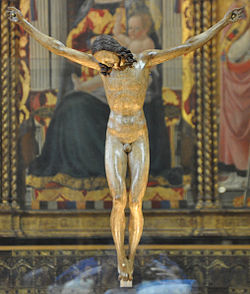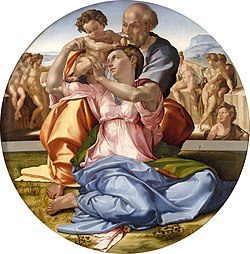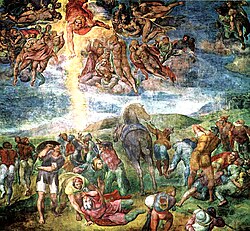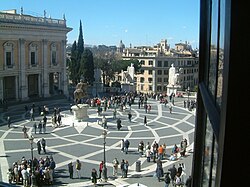The following is a list of works of painting, sculpture and architecture by the Italian Renaissance artist Michelangelo . Lost works are included, but not commissions that Michelangelo never made. Michelangelo also left many drawings, sketches, and some works in poetry.
| Image | Title | Year | Location | Material | Dimensions |
|---|---|---|---|---|---|
 | Christ of Guadalupe | 1560 | Guadalupe, Cáceres, Spain | Ivory | 20 cm |
 | Young Archer (in Italian) | c. 1491–1492 | Metropolitan Museum of Art, New York | Marble | height 97 cm |
 | Venus and Cupid (in Italian) | c. 1491–1492 | Palazzo Medici-Riccardi, Florence | Marble | 43,5x58 cm |
 | Gallino Crucifix (in Italian) | c. 1495–1497 | Bargello Museum, Florence | Wood | 41,3×39,7 cm |
| Young Saint John the Baptist [5] | c. 1495–1497 | Sacred Chapel of El Salvador, Úbeda | Marble | height 130 cm | |
 | Crucifix of Montserrat (in Spanish) | c. 1497–1498 | Santa Maria de Montserrat Abbey, Monistrol de Montserrat | Ivory | |
 | Naked man I (in Italian) | c. 1501–1504 | Casa Buonarroti, Florence | Terracotta | height 49 cm |
 | Importuno di Michelangelo | c. 1504 | Palazzo Vecchio, Florence | Pietraforte | |
 | Michelangelo Bronzes [6] | 1506–1508 | Fitzwilliam Museum, Cambridge, England | Bronze | |
 | Male torso I (in Italian) | c. 1513 | Casa Buonarroti, Florence | Terracotta | height 23 cm |
 | Male torso II (in Italian) | c. 1513 | Casa Buonarroti, Florence | Terracotta | height 22,5 cm |
 | Naked woman scale model (in Italian) | c. 1513 or 1532 | Casa Buonarroti, Florence | Terracotta | height 35 cm |
 | Cristo della Minerva (first version?) (in Wikimedia) | c. 1514–1516 | San Vincenzo, Bassano Romano | Marble | |
 | Palestrina Pietà [7] | c. 1555 | Galleria dell'Accademia, Florence | Marble | height 253 cm |
 | Scale model for a Crucifix | c. 1562 | Wood | height 20,5 cm | |
| Image | Details | Notes |
|---|---|---|
 |
| |
 |
| |
 (copy by Aristotile da Sangallo) |
|
|
 Detail: The Creation of Adam |
| |
 |
| |
 (copy by Peter Paul Rubens) |
| |
 |
| |
 |
| |
| Image | Details | Notes |
|---|---|---|
 |
| |
 |
| |
| Image | Building | City | Notes |
|---|---|---|---|
 |
| Rome | |
 (model in Casa Buonarroti) |
| Florence | Unexecuted |
 |
| Florence | |
 |
| Florence | |
 |
| Florence | |
 |
| Florence | |
 |
| Rome | |
 |
| Rome | |
 |
| Rome | |
 |
| Rome | |
 |
| Rome | |
 |
| Rome | |
 |
| Rome |
| Image | Details | Notes |
|---|---|---|
 |
| |
 |
| |
 |
| |
 |
| |
 |
| |
 |
|
![]() Media related to Michelangelo Buonarroti catalogue raisonné, 2007 at Wikimedia Commons
Media related to Michelangelo Buonarroti catalogue raisonné, 2007 at Wikimedia Commons